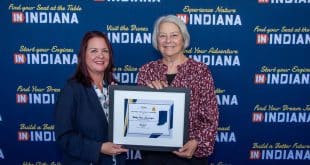INDIANAPOLIS (March 26, 2018) – Gov. Eric J. Holcomb on Friday sent a letter to U.S. Secretary of Labor Alexander Acosta requesting approval for a waiver that will allow the new Governor’s Workforce Cabinet to fill the role of Indiana’s federally-mandated state workforce development board. The Governor’s Workforce Cabinet was created this legislative session and outlines a smaller group with more authority to drive collaboration among employers and state and local partners.
Highlights of Indiana’s waiver request include:
- A smaller and more nimble cabinet with the authority to align resources, programs and partners
- More direct employer engagement
- Urgency and an expressed mission to prepare Hoosiers for jobs more efficiently, effectively and quickly
Secretary Acosta has indicated he is eager to work with states to offer them more flexibility to implement a structure and programs that will most benefit Hoosiers.
There is no specific deadline for a response, but the governor has requested an expedited turnaround.
| STALL OF INDIANA Eric J. Holcomb
OFFICE OF THE GOVERNOR Governor State House, Second Floor |
|
March 23, 2018
The Honorable R. Alexander Acosta, Secretary of Labor
United States Department of Labor
200 Constitution Ave. NW
Washington, DC 20210
Dear Secretary Acosta,
I write to respectfully request that Indiana be granted approval of a waiver on the membership of the state workforce development board under the Workforce Innovation and Opportunity Act.
As outlined in TEGL WIOA NO. 27-14, the U.S. Department of Labor encourages governors to take a broad and strategic view when appointing members of the state board. I have worked closely with state employers, legislators, state agencies, and other key stakeholders to determine a structure for the state workforce development board that would most benefit Hoosiers. Never before has Indiana succeeded in bringing our departments of education, workforce development, and economic development together with employers and our postsecondary training institutions with the authority to drive real implementation across our workforce system. This is what we need to align our state and federal workforce systems and more holistically meet the needs of those seeking training and employment opportunities.
During the 2018 Legislative Session, the Indiana General Assembly created the Governor’s Workforce Cabinet and designated it with the responsibilities of the state workforce board and the authority to direct state agencies to address our workforce needs. Additionally, this streamlined cabinet will be chaired by one of my most senior staffers who will report directly to me. The attached waiver request outlines the structure I believe will best serve Hoosiers, and your immediate approval, even as you assess our request, will enable our team to continue ongoing work.
If you have any questions or would like to discuss this further, please contact me or the chair of the
Governor’s Workforce Cabinet, Danny Lopez, at dalopez@gov.in.gov. We appreciate your consideration of this request and look forward to a quick and positive response.
Sincerely,
Eric J. Holcomb
Governor
WAIVER REQUEST STATE OF INDIANA
Waiver of State Workforce Board Membership
- Statutory and/or Regulatory Requirements the State would like to Waive:
State Workforce Development Board Membership and Establishment
Workforce Innovation and Opportunity Act (WIOA) Title I Subsection A Chapter 1 Section 101 (b)(1) — State workforce development boards: requirement to appoint specific members to the board described in section 101(b). The membership of the new Governor’s Workforce Cabinet may be found in Appendix 1.
This waiver will grant Indiana the flexibility to better align our state and federal workforce systems as follows:
- A true vision for workforce development driven by the Governor with input from employers across the state;
- Implementation of thoughtful strategies across state agencies;
- Better collaboration between state government and employers;
- Better collaboration between state leaders and local partners; and
- Better incentives for local partners and providers to get more Hoosiers into training and work.
Background
Indiana has for more than a decade made significant and crucial investments in our economic climate and positioned itself as one of the premier states in America in which to start and grow businesses. Governor Holcomb’s Administration is strengthening the foundation built by Governors Mike Pence and Mitch Daniels; low taxes, responsive government, responsible fiscal stewardship, a regulatory environment guided by common sense, and major commitments to our roadways, airways, and waterways. These qualities have made Indiana a model for the nation. Coupled with continual improvements in our K-12 system and our world-class network of nationally-acclaimed colleges and universities, Indiana is building a pipeline for sustainable success.
Our economy continues to evolve, however, and while our reliance on manufacturing remains an important competitive advantage, it simultaneously embodies our most pressing challenge. Manufacturing jobs increasingly demand higher and higher competencies, and coupled with the blossoming of our technology, biolifesciences, and aerospace defense industries, Indiana’s economy is straining a labor force that increasingly lacks the skills needed to remain competitive in the 21″ century.
According to the Lumina Foundation, only 41.9 percent of working-age people in Indiana have attained a high-value certificate or degree. More than 700,000 Hoosiers have begun but not completed postsecondary programs and another 400,000 lack any high school diploma or equivalency at all. Employers repeatedly point to growing demand, and education and training programs not only must operate with the same sense of urgency but must truly be in sync with the current and future workforce needs of their individual regions.
It is for precisely that reason that Governor Holcomb designed, and the Indiana General Assembly overwhelmingly codified, the new approach for which we seek this waiver. Never before has Indiana succeeded in bringing our departments of education, workforce development, and economic development together with employers and our postsecondary training institutions with the authority to drive real implementation. Moving from a 46-member state workforce board to a 21-member, employer-driven cabinet reporting directly to the Governor enables us to do just that. This way, we can ensure collaboration across State agencies while preserving the tenets of local control and employer guidance central to the spirit of the Workforce Innovation and Opportunity Act.
We must have a workforce system that fosters stronger collaboration among local governments, local workforce boards, various state agencies, and employers all across Indiana. Out model must facilitate the right incentives and corresponding support structures that give local workforce leaders the tools they need to move more Hoosiers toward employment. Conversely, it must challenge local employers, schools, and postsecondary institutions to engage and be responsible to support their own communities. In short, this must be an all-hands-on-deck approach, and the state must have the organizational structure in place to effectively guide implementation.
Our approach to the delivery and synchronization of our workforce preparation systems must evolve. With one of the nation’s lowest unemployment rates and a labor participation rate above the national average, we must implement a model that not only seeks to perfect our traditional workforce development programs but aligns those programs with resources and strategies that truly cut across the missions of so many State agencies. Moving more people into meaningful training and high-wage jobs will require us to look well beyond the Department of Workforce Development for support in areas like transportation, childcare, affordable housing, and substance abuse.
The gaps these Hoosiers face are set against the backdrop of increased need by employers. Job creators in Indiana continue to clamor for more workers across skill levels, and the number of unfilled jobs is approaching 100,000. Underemployment rather than unemployment remains a critical concern for both families and employers, and these workforce challenges are truly a threat to the incredible socioeconomic gains we have made for years.
We must have the structure in place that allows us to more collaboratively and strategically use state and federal resources from across agencies in Governor Holcomb’s Administration to tackle this multi-faceted challenge.
- Actions the State has undertaken to Remove State or Local. Barriers:
There arc no longer any state or local statutory or regulatory barriers to implementing the proposed
waiver.
The Indiana General Assembly passed and Governor Holcomb signed Senate Enrolled Act 50. The bill creates the Governor’s Workforce Cabinet to comply with the federal requirements for a state board under WIOA.
- State Strategic Goal(s) and Department of Labor Priorities Supported by the Waiver:
The goal of the waiver is to allow flexibility in the membership requirements of the state workforce development board under WIOA Sec. 101(b).
We have worked closely with state employers, legislators, state agencies, and other key stakeholders to create a structure for the state workforce development board that would most benefit Hoosiers. This flexibility is critical to better aligning our state and federal workforce systems, provide greater opportunity to more vulnerable and displaced Hoosiers, and meet employer workforce demands as our economy continues to evolve.
The Governor’s Workforce Cabinet will be focused on accomplishment, not activity. Many of these objectives speak directly to the policy priorities laid out by the United States Department of Labor.
Goal: Setting a single vision for workforce policy
Bringing the cabinet under the Governor’s Office and appointing one of the Governor’s senior leaders as Chairman ensures real synergy among state agencies charged with implementing our workforce programs. Indiana has struggled to bring the many departments that serve working-age Hoosiers together under an action-oriented mission, as previous attempts have resulted largely in recommendations and reports. With the weight of the Governor’s office behind it, the cabinet will direct each agency to work toward a unified set of goals for workforce policy, using existing data and ongoing assessment to determine and act upon changes can be immediately operationalized.
Goal: Identifying wrap-around solutions to break silos across resources
One of the challenges local workforce boards face is the inability to deliver outside-the-box solutions for their most vulnerable populations in the face of decreasing federal funding streams. The structure of the Governor’s Workforce Cabinet allows employers and workforce leaders to identify potential new resources for local boards, incentive new outcomes and more meaningful metrics, and foster region-wide collaborations to better serve prospective employees grappling with substance abuse addiction, housing issues, and more.
Goal: Increase accountability at the state, local, and service-provider levels
The Governor’s Workforce Cabinet will assess and align the state and federal resources for workforce training in a holistic way, and allow state agencies and education and training providers to move away from a compliance mindset to an action-oriented one. Currently, the state workforce board serves primarily as an advisory committee for WIOA programs and services. The Governor’s Workforce Cabinet, rather, has been tasked with identifying existing state and local roadblocks facing Hoosiers seeking meaningful training and employment, designing policy to address them, and ensuring solutions are operationalized at the agency level.
- Projected Programmatic Outcomes Resulting from Implementation of the Waiver:
The new state workforce board structure provides better support for true employer engagement. The composition of the Governor’s Workforce Cabinet provides an opportunity to hear from and provide solutions to employers in Indiana’s key sectors. The new cabinet also allows for a better
connection among employers, local workforce boards, state agencies whose constituent populations overlap with those served by WIOA, and statewide education and training providers. Duties of the cabinet include but are not limited to:
- Perform the duties as set forth in WIOA;
- Advise the governor on the coordination of federal, state, and local education and training programs and the allocation of state and federal funds in Indiana to promote effective services, service delivery, and innovative programs;
- Work with local workforce development boards;
- Design for implementation a comprehensive career navigation and coaching system;
- Conduct a complete review, analysis, and evaluation of workforce funding; and
- Direct the appropriate state agencies to implement changes to the delivery of workforce programs and make recommendations to the Governor and legislature.
- Individuals, Groups or Populations benefiting from the Waiver:
Local Boards will benefit from greater connectivity to state government and the Governor’s office, defined goals and clarity of mission, and the opportunity to access resources that may be available through a variety of state agencies.
Individuals will benefit from state and federal resources more strategically and cohesively dedicated to moving them into meaningful training and quality jobs. Individuals will have the support they need to move into sustainable employment.
- How the State plans to monitor waiver implementation, including collection of waiver outcome information:
The outcome of the waiver will be a statewide achievement of better communication and direction for the WIOA-established workforce system.
One of the functions of the Governor’s Workforce Cabinet is to review, monitor, and recommend changes to the state’s workforce system. As such, there will continually be an eye toward how Hoosiers are impacted by the policy decisions of the cabinet and the programs implemented at both a state and local level. Outcomes that result from aligning these systems will be included in the state’s annual WIOA report.
- Assurance of State posting of the request for public comment and notification to affected local workforce development boards:
This waiver request will not have a direct impact on the local workforce development boards. We will provide a letter to all local workforce boards notifying them of the state board membership changes, and the chair of the Governor’s Workforce Cabinet will meet with all local executive directors. The membership of the Governor’s Workforce Cabinet will be included in the updated state plan, which will be resubmitted for public comment.
The waiver request will be published for a period of three weeks on the public websites maintained by the Indiana Department of Workforce Development, allowing for public comment on its content and impact.
A copy of the waiver will be available for public inspection at the Indiana Department of Workforce Development offices and electronic copies of the waiver will be sent via e-mail to local boards and one-stop operators.
APPENDIX 1: Governor’s Workforce Cabinet Membership
The membership of the newly-established Governor’s Workforce Cabinet established consists of at least the following twenty (21) members:
(1) A chairperson appointed by the Governor.
(2) The secretary of career connections and talent.
(3) The commissioner of the department of workforce development.
(4) The president of the Indiana Economic Development Corporation.
(5) The commissioner of the Indiana commission for higher education.
(6) The superintendent of public instruction.
(7) The president of Ivy Tech Community College.
(8) The president of Vincennes University.
(9) A member appointed by the governor who is an apprenticeship coordinator of a joint labor-management apprenticeship program approved by the United States Department of Labor, Employment and Training Administration, Office of Apprenticeship.
(10)A member representing high school career and technical education directors appointed by the governor in consultation with the Indiana Association of Career and Technical Education Districts.
(11)A member representing manufacturing appointed by the governor in consultation with the Indiana Manufacturers Association.
(12)A member representing a minority business enterprise appointed by the governor.
(13)A member representing a women’s business enterprise appointed by the governor.
(14)A member representing a veteran owned business appointed by the governor.
(15)A member representing the nonunion and construction trades appointed by the governor in consultation with the Associated Builders and Contractors, Inc., and the Indiana Builders Association.
(16)A business owner appointed by the governor in consultation with the Indiana Chamber of Commerce.
(17)A small business owner appointed by the governor in consultation with the National Federation of Independent Businesses.
(18)A member of a community-based organization appointed by the governor.
(19)Three (3) at-large business owners appointed by the governor, one (1) of whom is a business
owner who employs less than fifty (50) employees.
20) Any additional members designated and appointed by the governor.
(b) The members appointed under subsection (a)(11) through (a)(19) must be geographically diverse.






